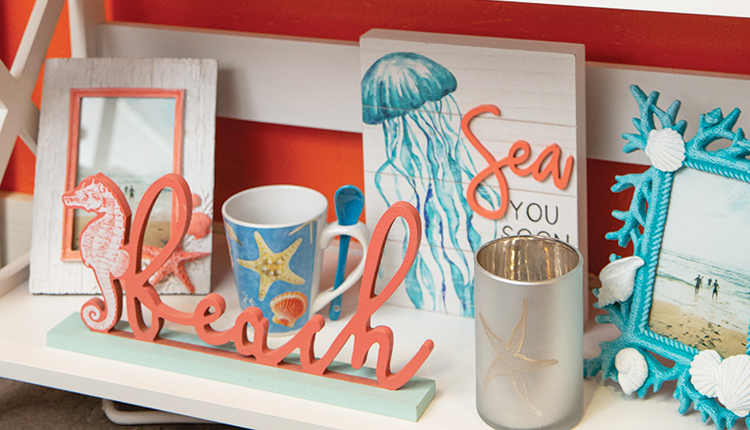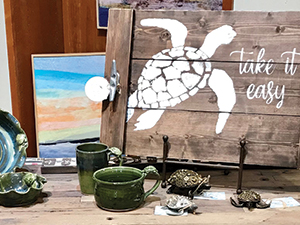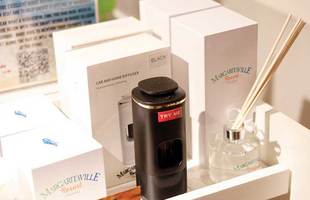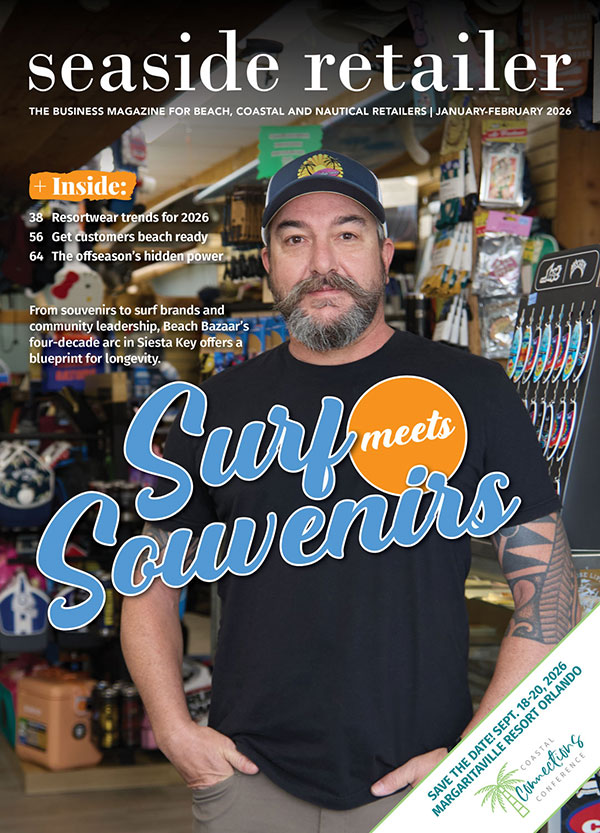
Making sales is something every seaside store owner wants — and not just one sale. Ideally every customer that visits your store will leave with multiple items. It’s up to you to create opportunities for your customers to see a variety of merchandise, and there’s a sure-fire way to accomplish that.
“How do you silently multiple-sell to any person who walks in? You do it by creating stories,” says Natalie Tan, owner of Retail Excellence Consulting, Burnaby, British Columbia, and author of the Seaside Retailer magazine’s Taking Stock column.
“We have a saying,” says Tan, “‘Don’t let anybody out of your store without buying three things.’ Good stories will help you do that.”
Several types of stories are waiting to be told inside your store. There are many different kinds of merchandise stories, according to Tan — color stories, theme stories, brand stories among others.
Vignettes and collections
Susan Sears knows the profit-building power of storytelling. The owner of three stores in Annapolis, Maryland, Local by Design, worked in the retail industry for over 20 years and has an extensive background in selling and merchandising products.
“The majority of people out there aren’t as creative at putting things together so it’s our job as retailers to show them,” explains Sears.
Sears, who calls her stories vignettes, says that this is especially true in the realm of home decor. “We can create a vignette that shows how these two pieces or five pieces of furnishings or decor can be put together in their home in an attractive way. It’s a learning experience for the customer.”
Sears says her entire store is set up with suggestive-sales stories. “Everything in the store is grouped together by theme or color, or by things that complement each other. That even includes lamps and throws.”
Sarah Wieck calls the stories she creates at her six Down the Ocean stores, collections. The four stores in Houston and two stores in Dallas, share space with other stores inside mercantile malls. Customers will find the mermaid collection, the pineapple collection, the flamingo collection … you get the idea.
Wieck says these themed groupings attract customers who gravitate toward those particular motifs. “Let’s say they love turtles, and they see a whole display of different turtle items — turtle beach towels, turtle drink cups — it just draws them in.”
Kara Wirin is one of the four co-owners of Bungalow Road, a gift store with three New Jersey locations: Avon-by-the-Sea, Atlantic Highlands and Seabright. Each store has a wedding section filled with picture frames, wine glasses, silver champagne buckets and fun mugs that say things like, “Does this ring make me look engaged?”
“Maybe someone wants to add a little something to a card with a money gift,” says Wirin. “The story suggests additional items to give a bridal couple.”
Color stories
One of the most common ways similar or disparate categories of merchandise can be grouped is by color. It’s been said that women in particular buy by color.
“A lot of our displays are color-driven,” says Wirin. “We’ll have soaps and hand creams and candles with labels that match those colors on a table together, and also place some books nearby that match that coloration. Grouping by color allows us to work a lot of different categories into that table.”
Wieck bases many of her groupings on color, putting together a turquoise hat and necklace with a turquoise pair of flip flops. Or, by grouping together items in complementary colors that work well together, such as a pink bathing suit, a purple beach coverup and a red tote with lilac flowers on it.
Grouping by color, Wieck says, is a good default for those straggler single items that she has left over. “Everything starts out as part of a collection, but as I sell through things I’ll be left with random items. I’ll put them together based on color with different hues that mix together well,” Wieck says.
Theme stories
A theme story is created by putting different categories of items together based on their common theme. The Bungalow Road stores have New Jersey sections with plates, mugs, towels and other items emblazoned with images of New Jersey maps.
Local by Design contains a store-within-a-store called The Drift Shop, filled with driftwood sailboats, signs and lamps. If items made of driftwood fail to float someone’s boat, there’s another area that has everything oyster-related with a big original oyster painting, oyster necklaces and oyster-can candles by Raymond Matthew.

Maybe crabs are someone’s thing. They could go to Local by Design’s crab-themed area with hand-painted crab wineglasses, crab soaps, crab hand washes and even a delightful folk-art crab made of bottle caps.
When Wieck gets in a new category of item for Down the Ocean, she will create a theme story around it.
“I’m shortly going to be getting in some flip-flops. When I do, I’m going to group them with a tote bag, a canvas sign and a brightly colored cap that all have flip-flop graphics on them.”
Brand stories
“If you carry well-known brands, you can do a brand story,” suggests Tan.
Wirin does this in her three Bungalow Road locations. All the Nora Fleming ceramics are grouped together. Corkcicle’s drinkware and Blue Q gifts each have their own groupings.
“In our little kid’s section, we carry a well-known brand called Jelly Cat, with books and matching plush toys,” describes Wirin. “We keep all of those Jelly Cat branded items together within the kid’s section.”
Sometimes a wholesaler will include a branded display along with its merchandise. Wirin says that she and the other co-owners usually don’t use the displays that vendors send, preferring to create their own stories — with a few exceptions.
“We have a couple of proprietary displays that we are using in the stores, like the ones from Blue Q and Scout. Blue Q has a nice display that puts their socks and potholders together.”
While those two categories of items — socks and potholders — would normally go in different sections, displaying them together works in the case of the Blue Q brand. The bright graphics and humorous sayings on the items all share a similar look. Someone who likes that brand and its look will tend to buy multiples across merchandise categories just like a pair of socks and a matching potholder.
Coordinating items and more
An item of clothing displayed with a coordinating accessory such as a scarf that goes well with it makes it more likely that a buyer with snap up both items. Wieck harnesses the power of coordinating-items stories in her stores.
“I coordinate accessories like hats and totes so people will hopefully buy both,” she says, adding, “When you have coordinating pieces that are put together nicely, people will say, ‘Oh, if I buy this, this other thing would go with it so well, just as it looks here.’ That builds multiple sales.”
In Bungalow Road’s women’s clothing sections, Wirin says she’ll hang a necklace on some of the items. “If we have six pieces of clothing, we’ll hang necklaces on a couple of the ones that are faced out.”
There are many other kinds of stories you can tell. A style story can be created by placing different items together with the same aesthetic, — shabby chic, modern or bohemian.
A calendar story takes advantage of an upcoming gifting occasion such as Valentine’s Day, Mother’s Day or graduation time. “ Mother’s Day at the beach story might include a beach picnic set with plastic dishes and cutlery, a beach umbrella and coordinated mother-and-daughter accessories.
“You would put that display right up front in your store,” Tan says. Someone looking for a creative Mother’s Day gift will be drawn into the store when they see it in the window.
Reading the stories
There’s a bit more to the story technique than just creating them, says Tan. You want to make sure your customers “read” them.

That is where a traffic plan comes in. “A traffic plan influences the way your customers walk your space,” says Tan. “Do you want them to go forward, or veer to the right? Or turn around and stop at certain points?”
She advises setting up a store display in such a way as to direct customers’ paths through your store so that they will view your merchandise stories in a certain order.
Tan says people have a predisposition to buying things that are adjacent to other items they’ve decided to buy. Retailers can use this tendency to their advantage.
“If I’ve placed sporting goods adjacent to sportswear, the two categories will have a symbiotic relationship,” says Tan. “They’ll feed off each other.”
A good store traffic plan will have one section flowing into the next one theme-wise. Each section in an aisle should have a tangential relationship to the section next to it so that each one segues logically into the next, according to Tan.
This is how it works: “If I’ve selected a beach chair, and out of the corner of my eye, I see you also sell beach towels, I will probably go to both areas without your even telling me,” Tan describes.
Creating merchandise stories isn’t difficult; it’s something any seaside retailer can do. Sears says, “If you do it long enough, it becomes second nature. You get so you see what goes with what and what complements what.”
What kinds of stories does your merchandise want to tell? Color, theme, branding, coordinating or some other story grouping that is waiting to be expressed?



